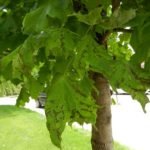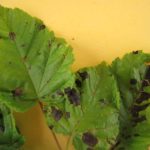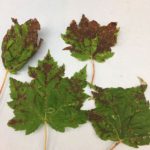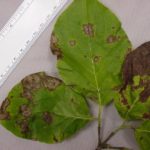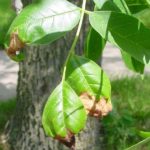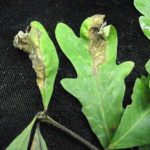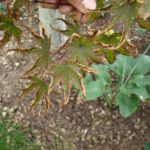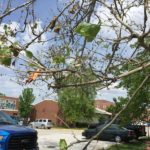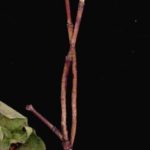One of the most common problems of broadleaf shade trees is a group of diseases collectively known as anthracnose. Anthracnose diseases are caused by fungi and become severe when cool, wet spring weather persists as leaves are first emerging. The most commonly affected trees are ash, white oak, maple, and sycamore. Dogwood, birch, elm, walnut, butternut, hickory, and other trees may also be damaged. Each species of tree is infected by a different species of fungus, thus the fungus does not spread from oak to maple or maple to ash or ash to sycamore. These fungi are referred to as host specific.
While anthracnose diseases vary somewhat from one type of tree to another, they all cause death of leaf tissue and defoliation. Symptoms most often include irregular leaf spots and blotches (Figs 1,2,3, 4 ) The areas near veins are often most damaged and can lead to curled and distorted leaf growth as the leaf expands (Figs 5,6). This is in contrast to noninfectious leaf scorch symptoms which tend to be located uniformly on the edges of leaves and between veins (Fig 7). Anthracnose fungi that survive the winter in leaf litter beneath the tree are carried by rain and wind upward in the spring to cause first noticeable symptoms in the lower branches. Often the very top portions of the tree escape infection and appear quite healthy in comparison to the lower sections of the tree. In some tree species, such as sycamore and dogwood, anthracnose fungi cause branch cankers and dieback (Figs 8,9).
- Fig 1 Anthracnose symptoms on maple leaves (PPDL)
- Fig 2 Anthracnose symptoms on Tartarian Maple ( PPDL)
- Fig 3 Maple anthracnose (PPDL)
- Fig 4 Dogwood anthracnose on foliage
- Fig 5 Ash anthracnose(PPDL)
- Fig 6 Oak anthracnose ( PPDL)
- Fig 7 Noninfectious (abiotic) leaf scorch (PPDL)
- Fig 8 Sycamore anthracnose branch cankers and dieback (PPDL)
- Fig 9 Dogwood anthracnose branch canker and dieback(PPDL)
While anthracnose can cause premature defoliation (Fig 10), it does not result in tree death. Vigorous trees are able to withstand infection and push out a new crop of leaves and recover with no long-term injury, and so the primary control for anthracnose is to maintain good tree health. Anthracnose infected trees need to grow more actively than they normally would in mid-summer to replace lost leaves. Thus, cultural practices that include maintaining a balanced fertilization program and watering during drought stress periods are important for the active growth required in the current season and for the regeneration of carbohydrate reserves in preparation for the dormant season. Removal of infected, fallen leaves will help reduce the amount of fungal inoculum that overwinters in leaf debris beneath the tree.
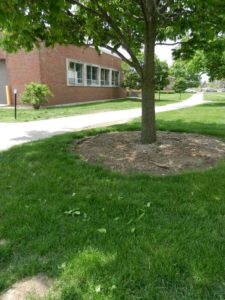
Fig 10 Ash anthracnose premature defoliation (PPDL)
Fungicides are generally not necessary but may be warranted to protect healthy foliage on a specimen or young tree. Thorough coverage and proper timing of the sprays are critical for adequate control. It is too late now to apply fungicides for maximum control of anthracnose since sprays applied after symptoms appear are of little benefit for infections that have already occurred. Anthracnose usually occurs on the same trees each year so it may be helpful to make note now of susceptible trees if you are planning on using fungicide applications next spring, so they can be made before infections occur.
Leaf Diseases BP-143-W (pdf file)
